
St Andrew's Church - Exwick
Page updated 31st July 2011
When this church was built in 1842 as a chapel of ease, it was considered to be 'the best example of a modern church we have seen yet' by the Cambridge Camden Society who were formed three years earlier, firmly establishing the architect John Hayward as one of their favourites, in the south-west. The Reverend John Medley initiated the Chapel at ease to St Thomas the Apostle ".. to meet the needs of its poor population living a long way from the parish church." He set up a subscription, and along with a loan of £500 from the Church Building Society, raised enough for the construction.
The foundation stone for the church was laid by James Wentworth Buller.
St
Andrew's Chapel, Exwick
This stone was laid July 30th 1841
By
J.W. Buller Esq. of Downes.
Vicar of St Thomas, Revd. J Medley
Architect
J Hayward Esq.
After the stone was laid, Buller then took a bottle, containing a parchment scroll, inscribed with a brief record of the event, and three small silver coins and embedded it in the stone wall.
John Moore was selected to build the church, and the Articles of Agreement, dated 30th July 1841, for its building were very precise over materials and methods of construction at an agreed cost of £869 10 shillings. Payment was in four parts, the first was £200 when the walls were erected, £160 when the roof was completed, £120 when the plastering and ceiling were finished and £389 10 shillings four months after completion. The pulpit was extra, while £30 was allowed for the Altar panelling and £5 for a stone font. It was stated that the work was to be done "... in the most workmanlike manner and with good sound and durable materials of the best quality of their several kinds." The chapel had to be ready by 1st June 1842.
Finally, on 26th September 1842 it was consecrated by the Rt Rev Bishop Phillpotts of Exeter. After the ceremony, a meal of roast beef and plum pudding was given to 250 local poor children in a nearby tent.
The chapel had free seating throughout, with no reserved pews for the Buller family. Built of Pocombe and Portland stone, the interior had stonework from Caen in Normandy, installed by Mr Rowe of St Sidwells. The east window, by Robert Beer of Exeter, was based on the design of stained glass at York Minster and the alter rails were a copy of those in the chapel of Edward the Confessor in Westminster Abbey - they didn't aim low for inspiration.
The sacked Curate
The 19th Century was a time of much ecclesiastical debate, which often raged between the Evangelicals and the Tractarians. Bishop Phillpotts of Exeter tended towards a middle path between the two, with a leaning towards the high church. When the evangelically minded Rev. Hibbert Newton was appointed to the Curacy of St Thomas and Exwick in 1850, he immediately came under suspicion. In January 1852, the Reverend was examined by the Bishop and found to be unsound on the doctrine of baptismal regeneration, and sacked from ministering in his parish. Exwick Chapel was closed for two Sundays after the judgment was served, much to the annoyance of the local parishioners. On the 18th January 1852, the parishioners published a declaration that "... they will not see a Christian and Protestant Minister suspended thus in a moment from stipend as well as duty, because he preaches the truth of the Gospel, as he finds it set forth in Holy Scripture, and in conformity with the Articles of the Church of England." They opened a subscription to raise a year's stipend for the Reverend, which received donations from W H Howard, the Vicar of St Thomas, Robert Maunder the owner of the woollen mill, John Rew, John Dinham, Thomas Latimer and many others; the notice listed more than £27 of subscriptions towards the £120 stipend of the hapless Rev., Newton.
The fire and the organ
In May 1856 an organ was installed in the church for the first time, which was played by Mr Hawker of St Sidwell. Ten years later, in March 1866, the chapel narrowly avoided destruction when a "little girl alarmed the neighbourhood seeing smoke issuing from the chapel, which had become ignited by reason of an overheated stove. Some injury was done to the organ, seats, &c."
The parish
William Gibbs of Tyntesfield, who made a fortune importing guano,
persuaded Buller to sell him the living of Exwick in 1872, and then
promptly transferred the patronage from James Howard Buller to himself, making St Andrews independent of St Thomas.
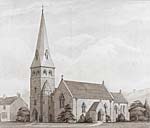 In 1873, the original architect, John Hayward, was brought back by
William Gibbs to remodel the church and enlarge it. This work was paid
for by Gibbs, who was also responsible for St Michael's Church at Mount
Dinham and the small Cowley Chapel. The chancel was lengthened and
polished marble pillars were installed, creating a north aisle;
stencils illustrating the Benedicite Canticle (Song of Creation) were added to the chancel
ceiling by Mr Roberts of St Thomas. There were also plans to add a
tower at the west end by St Andrew's Road, but it was not constructed – the documents suggest this was due to the objections of the lease holder of a strip of land adjacent to the proposed tower.
In 1873, the original architect, John Hayward, was brought back by
William Gibbs to remodel the church and enlarge it. This work was paid
for by Gibbs, who was also responsible for St Michael's Church at Mount
Dinham and the small Cowley Chapel. The chancel was lengthened and
polished marble pillars were installed, creating a north aisle;
stencils illustrating the Benedicite Canticle (Song of Creation) were added to the chancel
ceiling by Mr Roberts of St Thomas. There were also plans to add a
tower at the west end by St Andrew's Road, but it was not constructed – the documents suggest this was due to the objections of the lease holder of a strip of land adjacent to the proposed tower.
Around about 1880, a Hope-Jones patented electric-action organ was installed by Hele and Co., of Plymouth. It was installed in a chamber over the vestry, an arrangement which was not, acoustically, very satisfactory as it was next to the choir. In 1949, builders moved the pipes to a gallery at the rear of the church, while the keyboard remained at the front, right side, of the nave. It was connected to the relays that triggered the pipes by wires. Although electric lighting was added to the church in 1931, the organ was powered from a 12 volt car battery situated in the organ loft, which had to be periodically removed to a local garage to be recharged. Air, from the bellows, to drive the pipes was manually pumped, probably by an unlucky choirboy.
In 1992 work commenced to add over a three year period toilets, kitchen, office and a side entrance and a new gas fired boiler. The outer main entrance door was replaced with one made of Culm Valley oak.
The silver dispute
In 1916, the Rev., H C Brenton had a difficult start to his time at St Andrews due to a dispute over the church silver that had its origins back in 1863. In that year, the Vicar and Churchwardens of St Thomas, agreed to lend to St Andrews a chalice and paten for use in Holy Communion. A memorandum at the time, signed by Mr Thomas Snow and Mr R Maunder confirmed that they had received the silver, agreeing to keep them in good order, use them only at St Andrews and to return them if required.
The years rolled by, with St Andrews becoming a parish in its own right in 1873 – it was in 1916 that the current vicar of St Thomas made an inventory of parish property and discovered that a reference to the chalice and paten was found in the minute book. Thought to be worth £160, it was valued in June of the same year at £200. A request was made for the silver to be returned – the newspapers claimed that Exwick was hurt by the request to return the silver and considered that St Thomas only wanted it back when they discovered its value. Lawyers were engaged who ruled that the items were not on permanent loan and the silver was returned. The prominent local Snow family presented Exwick with its own pair of silver chalices and patens.
The church suffered blast damage during the May 1942 air raid – it is thought that a direct hit on a shelter at St David's Station, which killed eight men could have been the cause. Compensation was paid by the War Damages Commission for church repairs, but as times were austere, the compensation only covered the cost of replastering of the walls. The beautiful floral motifs on the wall, dating from 1873, were painted over. Some decoration remained including wall decorations of, William Morris, inspired orange trees and saints.
The Vicarage
Also in 1872 a new, large vicarage was built opposite the church, on the hill above Exwick Road, again, paid for by William Gibbs. He appointed his nephew William Cobham Gibbs as vicar, and gave him an endowment of £200 per year to support him. In October 1872 a small notice in the Flying Post stated that the house was being constructed by Messrs Moass, but that no plan had been submitted to the St Thomas Board. Approval must have been given for construction in the upper garden of the old Exwick Manor House continued. The building had a private chapel, dairy with cool shelves and stables next to Exwick Hill. It became the Diocesan Training Centre in 1983, and named Mercer House after the then Bishop of Exeter, although its present use is unknown. A new, smaller replacement vicarage was constructed just south of the old vicarage, in an urban style that will soon be forgotten.
The war memorial at the west end of the church grounds was designed by Mr T Easton and paid for with £107 10s raised by subscription from villagers. Inscribed on it are the names of fourteen men who fell in the First War and four from the Second War. It was dedicated on the 26th June 1920.
The Exwick Parish Institute, now known as the Exwick Parish Hall was built on land next to the church in 1921. The toll house on the opposite corner of Station Road belonged to the Buller's and, to avoid paying a toll, locals were said to nip through the churchyard on the way to St David's, bypassing the toll house. Tolls were discontinued on 7th October 1901, by the Mayor.
The Vicars of Exwick
There have been seventeen vicars of Exwick since 1842. Cousins, William Cobham Gibbs and John Lomax Gibbs were appointed by William Gibbs and his son, Antony Gibbs, respectively, both being nephews of William. John Lomax Gibbs accepted the living reluctantly, as William Cobham Gibbs had warned him that he had not had an easy time. John Lomax reminisced that "While I was at Exwick I had a visit from General Gordon just before he started on the expedition to Egypt which ended in his heroic defence of Khartoum and his death at the hands of the fanatical Arabs."
| 1838 | John Medley | 1933 | G S Trewin |
| 1845 | William Henry Howard | 1936 | James S Prowse |
| 1873 | William Cobham Gibbs | 1945 | Gordon H Samuel |
| 1879 | John Lomax Gibbs | 1950 | William L Roper |
| 1886 | G F Fagan | 1961 | Michael C Boyes |
| 1889 | Charles Dendy Blakiston | 1968 | Ralston A Smith |
| 1897 | L P Williams Freeman | 1973 | Roy C Dixon |
| 1912 | W T P Winter | 1982 | John Fairweather |
| 1916 | H C Brenton | 2009 | Jerry Bird |
Sources: Flying Post, a St Andrews history leaflet by John Fairwaether 1999, West of the River by Hazel Harvey and Michael Lowman and original documents held by St Andrews Church.
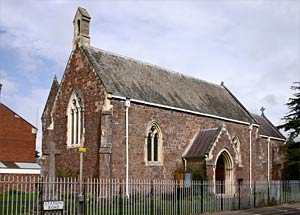 St
Andrew's Church, Exwick. The war memorial is to the left.
St
Andrew's Church, Exwick. The war memorial is to the left.
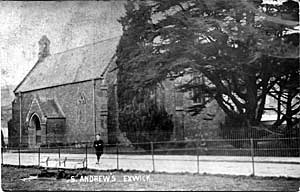 An old postcard of St
Andrew's Church, Exwick.
An old postcard of St
Andrew's Church, Exwick.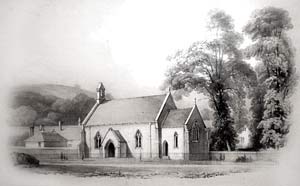 An
1842 print of the chapel – note Exwick Manor House at the rear left,
now the Village Inn. Courtesy the Devon & Exeter Institution.
An
1842 print of the chapel – note Exwick Manor House at the rear left,
now the Village Inn. Courtesy the Devon & Exeter Institution.
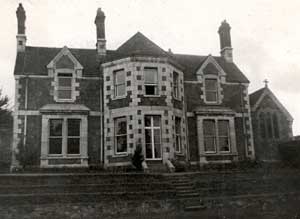 The
old Exwick Vicarage. Courtesy Dennis Hammond.
The
old Exwick Vicarage. Courtesy Dennis Hammond.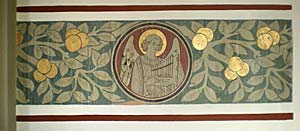 This decoration survived the bomb blast damage.
This decoration survived the bomb blast damage.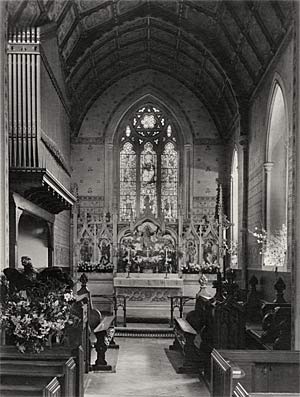 The iterior of St Andrew's Church in April 1936, showing the decorated walls.
The iterior of St Andrew's Church in April 1936, showing the decorated walls.
│ Top of Page │